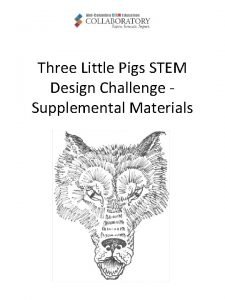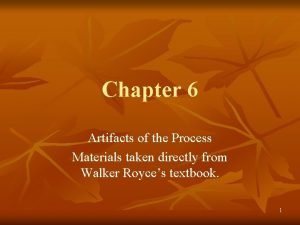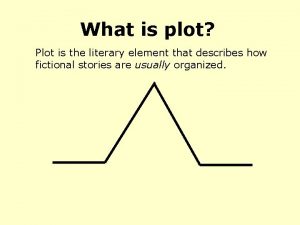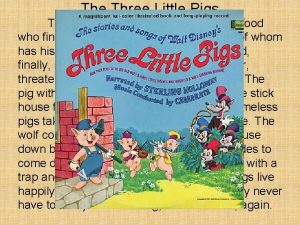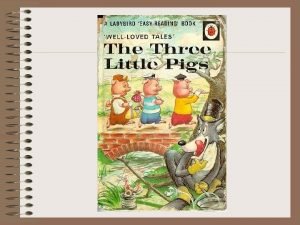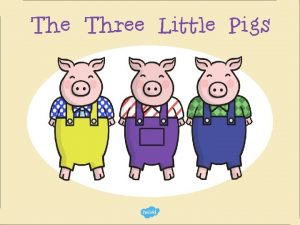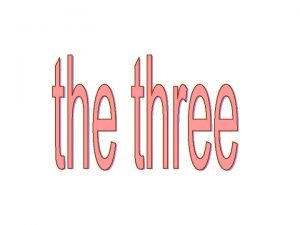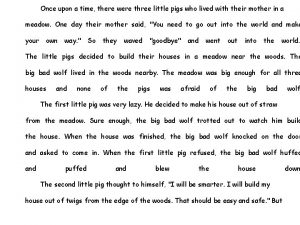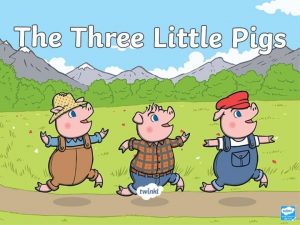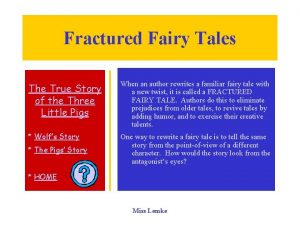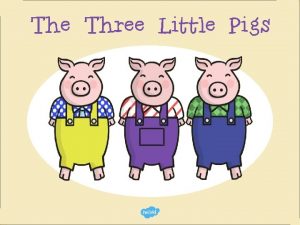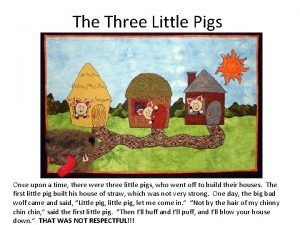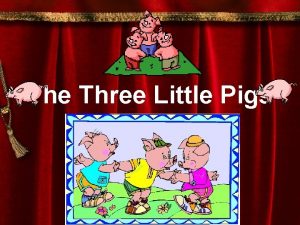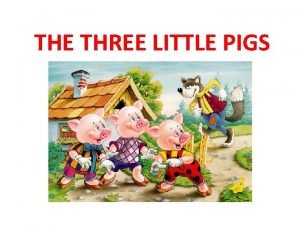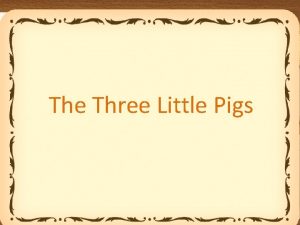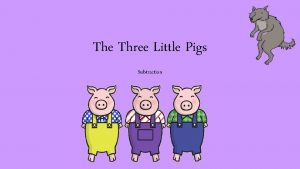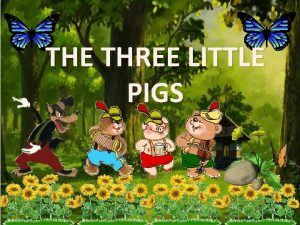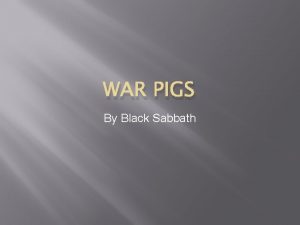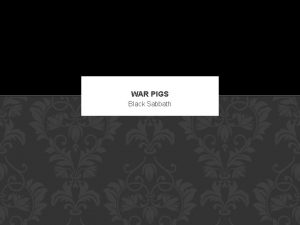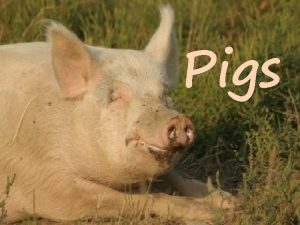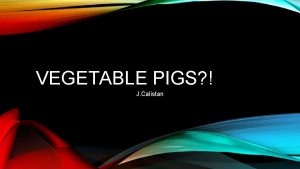Three Little Pigs STEM Design Challenge Artifacts from















- Slides: 15

Three Little Pigs STEM Design Challenge – Artifacts from Past Events LORIANNE DONOVAN, KIM FOWLER, JENNY RIEKE, FRANNIE SMITH, AND ELIZABETH STEPHENS Fall 2015 1

The Three Little Pigs STEM Design Challenge has been used with many audiences. Here are some artifacts from a fourth-grade classroom. STEM Design Challenge: Can your team design and build a house that the big, bad wolf cannot blow down? Design Requirements: 1. 2. 3. 4. Your house must be built on the foundation provided and use the roof provided. (Note: The roof is the top of the house and the foundation is what the house is built on. ) Your house must be built with only the materials you are provided. Your team must have “fair-share work”- listen to all ideas! Your team only has 20 minutes to complete this task and be ready for testing. 2

Southeastern Washington is a windy place. As such, this local newspaper article about a new STEM school that was damaged due to high winds was used to framework the reason WHY it is important to buildings that can withstand strong wind! High winds cause damage throughout Mid-Columbia What local, real-world connections can you think of? http: //www. tri-cityherald. com/2013/11/02/2654782/high-winds-causing-damage-throughout. html 3

Here are 3 slides we use to explain the “Engineering Design Process. ” Modify to suit your audience. What is the Engineering Design Process? A problem solving-tool that can be used as an approach to create solutions to problems. We also encourage you to look at: NGSS Appendix I – Engineering design in NGSS for another representation of the design process. Note the similarities and differences. 4

Some more details about each step… Identify the problem, criteria and constraints (e. g. , listed in the Design Challenge). Collect background information and generate solutions to address the problem (e. g. , what do you already know about strong houses? ). Explore ideas more thoroughly and select an approach your team thinks will solve the problem the best. Documentation (e. g. , drawing ideas out, etc. ) is important here! Build and evaluate design based on criteria (did it work? ). If criteria not met, redesign, rebuild and reevaluate. If criteria met, how could you make your design better, stronger, or more cost-effective? Summarize your process and findings, then communicate results (via report, poster, presentation, etc. ). [Reflection piece here] 5

What to document in the “Engineering Design Process” • • State the challenge problem in your own words (purpose) Describe background information learned Specify the design requirements (criteria) List any limits on the design due to available resources and/or environment (constraints) • • Draw sketches of potential designs Record pros and cons of each design Document materials Describe tests used for evaluation and describe how your design performed (via tables, charts, etc. ) Record observations If criteria not met, describe any iterations (i. e. changes) of the design Summarize results Describe any future improvements 6

These pictures illustrate the design challenge in action with fourth-grade students. House of straws (above) House of sticks (left) House of bricks (below) The “Big-Bad Wolf” box fan. 7

An example of what the data table might look like after testing. Data Table Building Material Huffing & Puffing Level 1 (fan on low) Huffing & Puffing Level 2 Level 3 (fan on medium) high) Straws Sticks m a ex e l p Note: To measure wind-speed, an anemometer (instrument to determine wind speed) can be used at the same distance the houses are placed from the fan. Bricks 8

Examples of student reflection pieces after working on the design challenge. 9

Here is another set of pictures from when we used the design challenge as part of a workshop with earlychildhood educators. Note the variation of building materials. Cleaned and cut “Tetra pak” carton material for “bricks”. Index cards for “bricks”. Corrugated cardboard (under the roof) for “bricks”. 10

Reuse: How to clean and prepare Tetra Pak cartons for building materials (slide 1 of 2) 11

Reuse: How to clean and prepare Tetra Pak cartons for building materials (slide 2 of 2) 12

Variations on materials for the design challenge are infinite. Here three different types of plastic straws are pictured. For sticks, think about popsicle sticks, wooden stirring rods, wide tongue depressors, real twigs, etc. Note: Cleaned out tin cans, yogurt containers, plastic jars, etc. make great portable holders for all kinds of building materials! 13

Materials are everywhere. Let your creativity flow with some reuse and recycling! 14

What will the Three Little Pigs STEM Design Challenge look like in your world? 15
 Stem 3 little pigs
Stem 3 little pigs Pragmatic artifacts
Pragmatic artifacts Plot diagram of a sound of thunder
Plot diagram of a sound of thunder The three little pigs falling action
The three little pigs falling action Once upon a time there was three little pigs
Once upon a time there was three little pigs Once upon a time there were three little pigs
Once upon a time there were three little pigs Once upon a time there was three little pigs
Once upon a time there was three little pigs The three little pigs once upon a time there
The three little pigs once upon a time there Once upon a time there lived three little pigs
Once upon a time there lived three little pigs Fractured fairy tales examples
Fractured fairy tales examples What does the wolf symbolize in the three little pigs
What does the wolf symbolize in the three little pigs Once upon a time there lived three little pigs
Once upon a time there lived three little pigs Once upon a time there were three little pigs
Once upon a time there were three little pigs Three little pigs realistic
Three little pigs realistic Nifnif
Nifnif A retrieved reformation plot diagram
A retrieved reformation plot diagram
